Western Digital Caviar Green 3TB and My Book Essential 3TB Drives Reviewed
by Anand Lal Shimpi on October 19, 2010 1:43 PM EST- Posted in
- Storage
- HDDs
- Western Digital
- 3TB
Overall System Performance using PCMark Vantage
Next up is PCMark Vantage, another system-wide performance suite. For those of you who aren’t familiar with PCMark Vantage, it ends up being the most real-world-like hard drive test I can come up with. It runs things like application launches, file searches, web browsing, contacts searching, video playback, photo editing and other completely mundane but real-world tasks. I’ve described the benchmark in great detail before but if you’d like to read up on what it does in particular, take a look at Futuremark’s whitepaper on the benchmark; it’s not perfect, but it’s good enough to be a member of a comprehensive storage benchmark suite. Any performance impacts here would most likely be reflected in the real world.
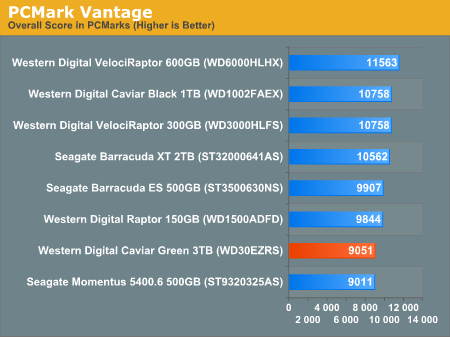
PCMark Vantage shows us the real world performance of the 3TB Caviar Green isn't so great if you're using it as a boot/application drive. The HDD specific suite is particulary troublesome as the drive is barely faster than Seagate's 2.5" 5400.6.
The memories suite includes a test involving importing pictures into Windows Photo Gallery and editing them, a fairly benign task that easily falls into the category of being very influenced by disk performance.
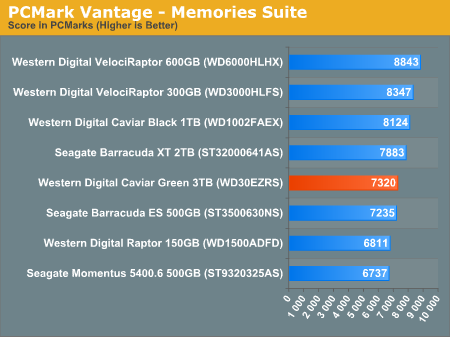
The TV and Movies tests focus on on video transcoding which is mostly CPU bound, but one of the tests involves Windows Media Center which tends to be disk bound.
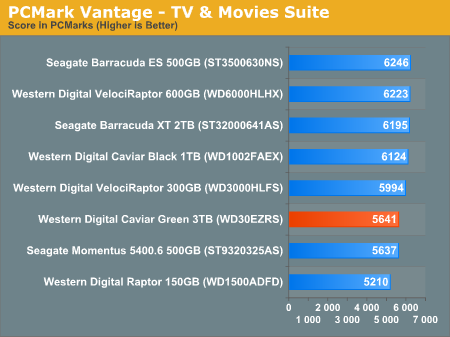
The gaming tests are effectively read tests since they spend a good portion of their time focusing on reading textures and loading level data. Actual game loading performance will differ depending on the game. Take these results as a best case scenario of what can happen, not the norm.
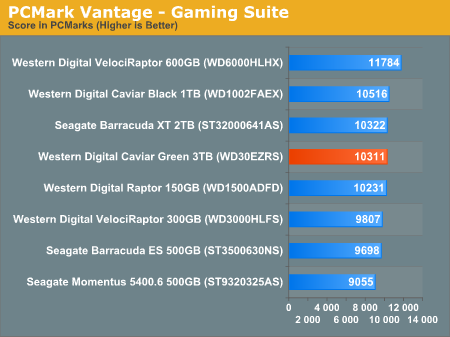
In the Music suite the main test is a multitasking scenario: the test simulates surfing the web in IE7, transcoding an audio file and adding music to Windows Media Player (the most disk intensive portion of the test).
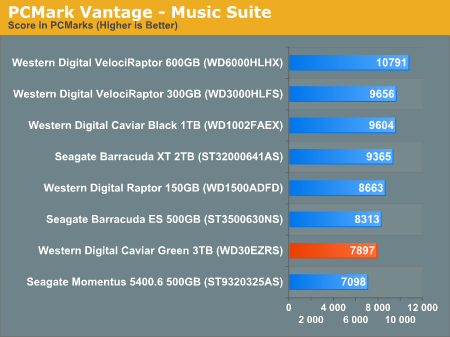
The Communications suite is made up of two tests, both involving light multitasking. The first test simulates data encryption/decryption while running message rules in Windows Mail. The second test simulates web surfing (including opening/closing tabs) in IE7, data decryption and running Windows Defender.
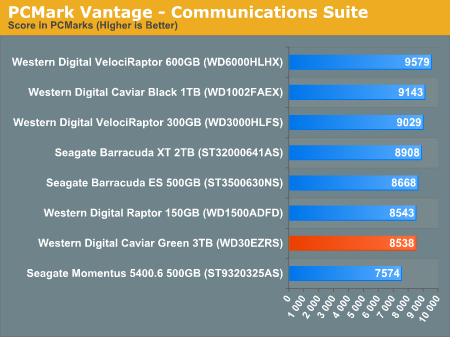
I love PCMark's Productivity test; in this test there are four tasks going on at once, searching through Windows contacts, searching through Windows Mail, browsing multiple webpages in IE7 and loading applications. This is as real world of a scenario as you get and it happens to be representative of one of the most frustrating HDD usage models - trying to do multiple things at once. There's nothing more annoying than trying to launch a simple application while you're doing other things in the background and have the load take forever.
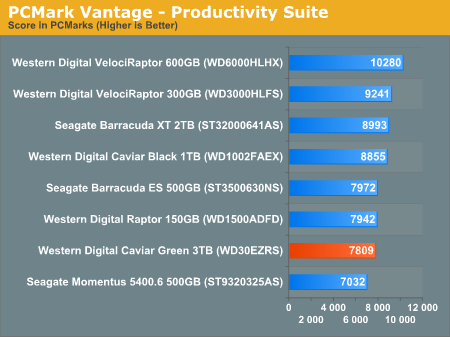
The final PCMark Vantage suite is HDD specific and this is where you'll see the biggest differences between the drives:
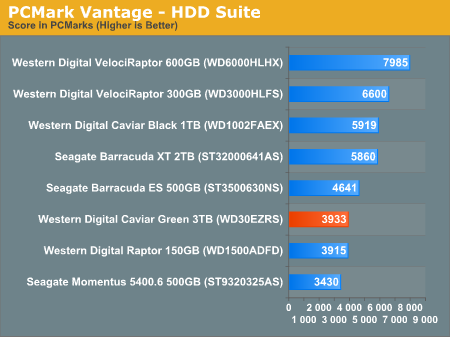










48 Comments
View All Comments
pvdw - Wednesday, October 20, 2010 - link
I use Linux MD RAID 10 (near-copies) on my home "server". For those who don't know, this is a non-standard RAID level that simulates RAID-10 using only two drives. In addition to redundancy this provides read speed improvements and some write speed improvement. I've set up automatic backups to protect from user error; and use Linux, so no viruses (yet). So I'm protected from all but fire/theft/bomb/hurricane/etc. For this I have off-site storage that syncs on a less frequent basis.Since we've had a number of power cuts here recently, the RAID setup also gives extra security.
Also, I don't know where you get your data from. None of my customers have lost data due to malware (I recover data from systems riddled with them), theft, or fire, but they have due to disk failure. I would put user error at the top of the list. I can see theft moving up the list due to the increase in portable data storage (tablets, smartphones, etc.)
daneren2005 - Wednesday, November 23, 2011 - link
You must be kidding me. Although it happens, not a single person I know has ever had a fire in their house. House break ins once again happen, but are not every day occurrences. I haven't heard of a widespread wipe virus since the early XP days. And when it comes right down to it, the common backup method (external HDD) prevents NONE of these things either. For 99.9% of the population, a RAID 1 provides IDENTICAL protection as an external backup drive. Especially since most consumer backups delete files that were deleted on the main drive, anything but a immediately noticed user error/virus wipe (and usually getting it out of the trash is going to be enough for these cases) would be propagated to the external drive as well.Now I both backup (update ~once a moth and store at brothers house) and RAID my data, but I do both because neither is enough by itself, but RAID isn't any less of a backup option then external backups.
CharonPDX - Tuesday, October 19, 2010 - link
I've had Intel Desktop boards for a few years that support EFI boot. I installed Windows 7 this way onto a 3 TB Intel chipset RAID a while ago, no problem. (Boot to the EFI installer on the Windows 7 disc, rather than the BIOS installer.)TSnor - Tuesday, October 19, 2010 - link
re: "Simply look at worst case seek time and you’ll get an idea for how quickly the platters are spinning" Worse case seek time should be the time it takes the heads to move from one extreme to another. While there might be a correlation between seek time and RPM, it would be because high performance drives tend to maximize both and green drives accept compromises on both.re: "Random performance is significantly lower, presumably because of the translation that happens at the USB controller level. " No, reading random 4K records is much harder for disk drives than reading sequential data. The R/W heads need to get positioned to the correct track between each random IO operation (that's the 'seek time' above) and the correct data has to rotate under the R/W heads (that's rotational latency effected by drive RPM). Reading sequential data the disk drive just reads each record as it comes under the R/W head, with a 1 cylinder (very short) seek to get to the next cylinder. This is why rotating disks can compete with SSDs for sequential data but get crushed on random data.
dertechie - Tuesday, October 19, 2010 - link
He's comparing the 4K reads of the external drive to the 4K reads of internal and other HDDs, not to sequential reads. If you actually look, you'll note that the drive lost over half of its random 4K read performance when using it over USB3 (0.18 MB/s) compared to the numbers it posts as an internal drive (0.40 MB/s). Write performance also dropped compared to internal, but not as much.TSnor - Tuesday, October 19, 2010 - link
re: "If you actually look..." ok. I agree with you.Sufo - Wednesday, October 20, 2010 - link
um, pretty sure he was comparing the internal drive to the external one here (so essentially sata to usb 3). I would be surprised if Anand had forgotten that random reads/writes are slow work on mechanical drives - it's not been that long since he published the last round of articles on the subject...Sufo - Wednesday, October 20, 2010 - link
oops sorry, didn't check next page >_<Dainas - Tuesday, October 19, 2010 - link
Anand,Can you please do some reviews on Samsung's Spinpoints? Only asking because Western Digital and Seagate always seem to have this or that issue with their +1TB drive. Also from what I've seen Samsungs efforts are also consistently faster and more reliable. Would be nice to know what you think of them.
musicman1352000 - Tuesday, October 19, 2010 - link
Yes please!Also, what happened to the noise figures?